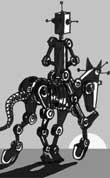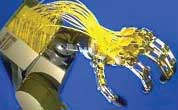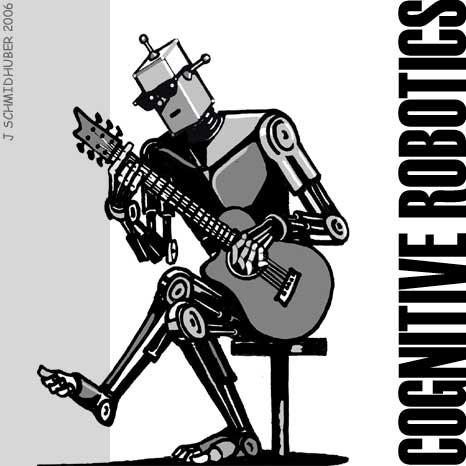 |
Mission:
to build robots that learn.
Tools:
recurrent networks,
Bayesian methods,
reinforcement learning,
evolution, optimal search,
others.
|
|
|
Theory: optimal universal learners,
universal Bayesian induction,
Kolmogorov complexity,
Gödel machines.
|
|
 |
|
|
|
We are living through a
robot population explosion.
In 1980 there were
just 30,000 robots; in 2002, already 1,000,000, almost half in Japan,
one third in Europe, especially in Germany,
the world's 2nd-largest market for robots.
But nearly all robots are prewired; they cannot learn
from experience like humans do.
And the few that adapt usually just react to their
current sensory inputs without making use of relevant events
further in the past. Is there an optimal
way of learning non-reactive behaviors in general, unknown
environments? Our recent theoretical insights affirm that
the answer is yes. And our biologically plausible
approaches use adaptive recurrent neural networks with
internal states to control
autonomous robots in
realistic, partially observable environments.
Check out the CoTeSys site of Schmidhuber's group
in the CoTeSys cluster
of excellence! Research topics:
artificial curiosity
for the DLR artificial hands,
behavior evolution for AM's
180cm walking biped,
visual attention & unsupervised learning
for adaptive robots.
|
|
|
According to Nature's millennium issue, the most influential
invention of the 20th century was the one that triggered
and sustained
the human population explosion: the
Haber- Bosch process.
Billions of people would not even exist without it.
The robot population explosion
is most visible in a few countries where the human one has
stopped,
and might eventually overtake it,
once cognitive robots no longer have to be hardwired but learn by themselves.
|
|
|
|
Why come to TUM? It
is a leader in the fields of automation and robotics,
with many unique and expensive robots, and
strong connections to
industry leaders such as
Munich's
BMW
and
Siemens.
14 Nobel laureates
(the most recent one of 2005)
are associated with Munich, 4 of them with TUM.
The FOCUS survey (20 Sept 2004) ranked TUM first among Germany's
universities, right ahead of Munich's LMU.
On 10/13/2006 both TUM and LMU were selected as two of
the three German "Elite Universities" by the
"Excellence Initiative" funded by 1.9 billion Euros for the next
5 years. This was prime time news on all German channels.
Fibonacci web design
by J. Schmidhuber
|
|
|
Why come to
Munich?
It is one of the world's most livable places
(ranked 2nd among the world's cities with over a million inhabitants, after Vienna, according to this
survey),
and gets consistently voted as Germany's most attractive city.
Lots of culture & fun, 100,000 students,
the world's largest festival
(Oktoberfest),
the world's oldest & largest
technical museum,
scenic Bavarian surroundings with lakes, rivers, hills, meadows,
bikepaths, castles, and beer gardens, close to major ski areas etc.
Schmidhuber has seen the world, and claims there is no
more beautiful region than the pre-alpine land between Munich and the Alps.
(He is biased though - he was born in Munich.)
|
|
|
Why come to Germany?
It is a fine place for scientists and inventors, with
a long tradition of
fundamental breakthroughs
that define today's world,
including Western
bookprint,
the calculator,
binary arithmetics & calculus,,
watches & other small machines,
math a la Gauss,
the second industrial revolution based on the
combustion engine &
the car
& the first practical dynamo & electric locomotion, the
germ theory
of disease,
the modern research university,
general relativity,
quantum physics,
population explosion,
the transistor,
the computer,
controlled
heavy flight, the helicopter, the jetplane,
cruise missiles,
uranium fission,
X-rays,
and innumerable others.
|
|
|
For most of the 20th century Germany boasted
more Nobel prizes than any other nation (until 1956;
until 1965 if we consider
only the laureates' countries of birth; until 1975
if we consider only the sciences).
It is still the world's largest exporter.
It is also the world's second largest maker and user of robots,
after Japan, and birthplace of the first robot cars.
Many of its teams became world champions
in the RoboCup, the most visible robot competition
(more).
|
|



























